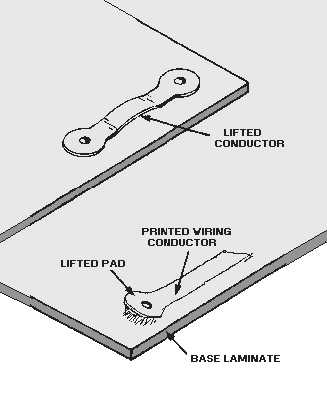3-34
REPAIRING DELAMINATED CONDUCTORS.—DELAMINATED CONDUCTORS (figure 3-
26) are classified as conductors no longer bonded to the board surface. Separation of the laminations may
occur only on a part of the conductor. Proper epoxying techniques ensure complete bonding of the
conductor to the circuit board laminate. The following procedures are used to obtain a proper bond:
Figure 3-26.—Delaminated conductors.
1. A small amount of epoxy is mixed and applied to the conductor and the conductor path; no areas
are left uncoated.
2. The conductor is clamped firmly against the board surface until the epoxy has completely cured.
REPLACING EYELETS.—Eyelets have been referred to in several places in this topic. Not only
are they used for through-the-board terminations, but also to reinforce some types of board repairs. As
with any kind of material, eyelets are subject to damage. Eyelets may break, they may be installed
improperly, or they may be missing from the equipment. When an eyelet is missing or damaged,
regardless of the kind of damage, it should be replaced. The guidelines for the selection and installation of
new eyelets are far too complex to explain here. However, they do comprise a large part of the 2M
technician's training.
Repair of Cracked Boards
When boards are cracked, the length and depth of the cracks must be determined. Also, the
disruption to conductors and components caused by cracks must be determined by visual inspection. To
avoid causing additional damage, the technician must exercise care when examining cracked boards and



